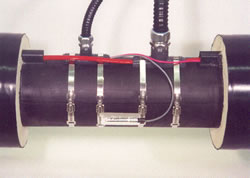Electric Heat Tracing on Plastic Pipes
Since the thermal resistance of plastic is significant (125 times that of steel), the heat tracing density for plastic pipes must be considered carefully. Particular care must be taken when calculating the THERMOCABLE® capacity for thick walled, large diameter plastic pipe. In some cases, it may be necessary to install two conduits or more, and cables with reduced watt output. This will ensure more even heat distribution and penetration, while not permitting to exceed the maximum permissible temperature of the pipe wall. For example, two conduits with cables would be required to trace a 350 mm (14 in) series DR 11 polyethylene pipe whose wall thickness is 35.3 mm (1.39 in). Urecon performs these calculations on computer using proprietary software; please consult us for your specific design requirements.
Once the required number of watts per unit length of heating required has been determined (either by table 1, formula 1 or Urecon's computer print out), we must be assured that the pipe wall temperature under the cable will not exceed recommended limits.
The formula to determine the pipe wall temperature under the heating cable in a conduit is as follows:

 |
Where: Tc = temperature of pipe wall (°F) Ws = Watts per foot of tracer Cl = Perimeter of conduit (in) Ti = thickness of insulation (in) Ki = K value of insulation (BTU • in / hr • ft² •°F) Tj = thickness of jacket (in) Kj = K value of jacket (BTU • in / hr • ft² •°F) Cw = width at base of conduit (in) Kp = K value of pipe wall (BTU • in / hr • ft² •°F) Tp = thickness of pipe wall (in) Tm = maintained temperature (°F) |
|||||||||||
|
Select a tracer wattage greater than the heat loss of the pipe, then calculate the pipe wall temperature using the above formula. If the resultant pipe wall temperature is above the recommended maximum, try two conduits and two runs of a lower wattage cable and re-calculate the formula. The sum of the wattage of the two runs of cable must exceed the heat loss of the pipe, including the safety factor.
The location of the heat tracing conduit is not significant on pressurized systems (full); however, placing it on top will improve the contact of the THERMOCABLE® to the pipe and increase the heat transfer efficiency, thus reducing the heating cable operating temperature. The cable is usually located on the top of buried water pipes (12 o'clock) for easier access. For partially full gravity sewer lines, the cable is usually located in the bottom quadrant.

